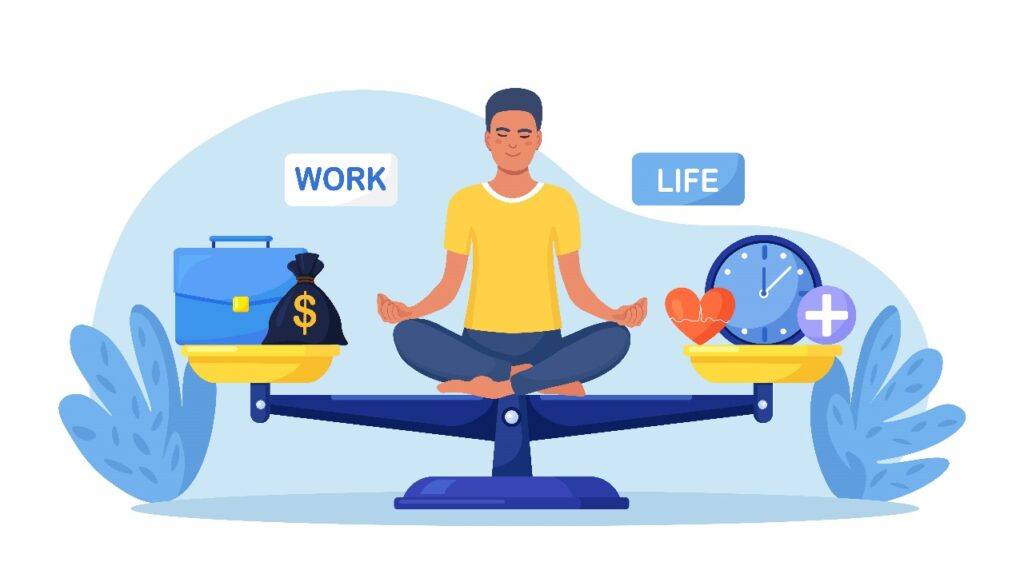Now Reading: Find Your Flow: Your Ultimate Guide with Tips for Maintaining Work-Life Balance
-
01
Find Your Flow: Your Ultimate Guide with Tips for Maintaining Work-Life Balance
Find Your Flow: Your Ultimate Guide with Tips for Maintaining Work-Life Balance

Remote work is the new normal, but burnout is real. This guide provides expert tips for maintaining work-life balance. Learn to set boundaries, manage your schedule, and use technology to your advantage. It is time to thrive, not just survive, in your home office.
Work from home is a dream for many. For instance, you can skip the long commute and wear comfortable clothes. But this dream has a tricky side, making tips for maintaining work-life balance essential.
Your office is now your living room. Also, your laptop is always nearby. As a result, the line between “work time” and “home time” gets very blurry.
This blurriness is a big problem. In fact, 2025 surveys show that while 83% of people love hybrid work, their biggest challenge is feeling “always on.” This feeling, subsequently, leads to stress. Therefore, learning to separate work from life is more important than ever.
This guide shares practical tips for maintaining work-life balance. These steps are simple. That is to say, even a fifth-grade student can understand them. Above all, they will help you get your time back. In short, you can be great at your job and still have a happy, full personal life.
The Big Shift: From “Balance” to “Integration”
For years, we talked about “work-life balance.” This idea felt like a scale, or a constant fight. However, in 2025, experts talk about “work-life integration.” This is a new, smarter way to think. To clarify, integration is not a fight. It is a flexible blend. In other words, work and life fit together.
What is Work-Life Integration?
Think of it this way. “Balance” means you must stop work at 5 PM sharp. This is very rigid. On the other hand, “Integration” means you have more control. For example, you stop working at 3 PM to pick up your kids. Later, you finish a report after they sleep.
Your work gets done. In addition, your family also gets your time. This flexible schedule is the key. As a result, it reduces stress. Above all, it is one of the best work-life integration strategies for long-term success.
Your First Step: Building a Wall (Even a Fake One)
The most important of all tips for maintaining work-life balance is to create separation. When you work in an office, the commute helps your brain switch off. But at home, you must create this “switch” yourself.
Create a Dedicated Workspace
This is a vital tip. You need a specific spot just for work. It can be a small desk in a corner. When you sit here, your brain knows it is time to work. Similarly, when you leave, your brain knows it is time to relax.
This physical boundary creates a mental boundary. So, try not to work from your couch. That place is for relaxing.
Set Clear Start and Stop Times
A flexible schedule is good. However, “flexible” should not mean “working all the time.” You must decide when your workday starts and ends. For example, you might decide to work from 9 AM to 5 PM.

Stick to these times as much as possible. Furthermore, tell your boss and your team. Let them know you are available during these hours. This helps manage their expectations.
The Power of “Off”: Taming Your Tech
Technology keeps us connected. But it can also be a trap. Notifications make you feel like you must reply right away. This is a fast track to managing burnout while teleworking.
You must control your tech. Turn off email and chat notifications on your phone after your workday ends. You do not need to answer a message at 9 PM. After all, most things can wait. This small change gives you back your evenings. Consequently, it lets your mind truly rest.
Smart Work, Not Hard Work: Remote Work Productivity Tips
Working longer does not mean working better. Smart work is about focus. These remote work productivity tips are also key tips for maintaining work-life balance. They help you get more done in less time.
Focus on One Thing at a Time
Your brain cannot multitask. In reality, when you think you are multitasking, you are just switching tasks quickly. This is tiring. Moreover, it also leads to more mistakes.
So, try “single-tasking.” Close all your extra tabs. Put your phone on silent. Work on only one project for a set amount of time. You will be amazed at how much faster you get it done.
Use the Pomodoro Technique
This is a very popular time management trick. Also, it is very simple.
- First, set a timer for 25 minutes.
- During that time, work on one task with full focus.
- Then, take a 5-minute break. Stand up, stretch, or get water.
- After four rounds, take a longer 15-minute break.
This technique works well. For one thing, it forces you to take breaks, which prevents burnout. It also makes big projects feel less scary. You just have to work for 25 minutes.
Plan Your Day (Just 10 Minutes)
Do not start your day by checking email. Because that lets other people set your schedule. Instead, take 10 minutes each morning to make a short to-do list.
Write down the 3 most important things you need to do. Do those things first. This way, you make progress on your big goals. You will feel a strong sense of accomplishment.
Your Guide to Flexible Work (A Hybrid Work Schedule Guide)
By 2025, the hybrid work schedule is the new normal. This means you work from home some days and go into the office on other days. This model offers the best of both worlds. A good hybrid work schedule guide must include tips for maintaining work-life balance.
How to Make Hybrid Work for You
A good hybrid plan is about being intentional. In other words, you must plan your week with a purpose.
- Use Home Days for “Deep Work”: Schedule your “at home” days for tasks that need deep focus. This includes writing, coding, analyzing data, or planning. As a result, you will have fewer interruptions.
- Use Office Days for “Team Work”: Save your “in-office” days for human connection. For instance, schedule your team meetings, brainstorming, and one-on-ones for these days.
The Risk: “Productivity Paranoia”
A new challenge in 2025 is “productivity paranoia.” This is when managers worry that employees at home are not really working. As a result, they might unfairly favor the people they see in the office.
You can fight this. The key is to over-communicate. Be visible. Most importantly, focus on results, not hours. For example, instead of saying, “I worked for 8 hours,” say, “I finished the client report.” This shows your value clearly.
Don’t Be a Digital Ghost: Remote Team Collaboration
Working from home can be lonely. In fact, studies show loneliness is a top reason for burnout. That is why using remote team collaboration tools is about more than just work. It is also about connection.
The Right Tool for the Right Job
You do not need 20 different apps. On the contrary, that just creates confusion. Instead, you need a few good tools that your whole team agrees to use. A simple setup is often the best.
Here is a look at common tools and what they are best for:
| Tool Category | Examples (2025) | Best Used For |
| Instant Chat | Slack, Microsoft Teams | Quick questions, saying “good morning,” and team bonding. |
| Video Meetings | Zoom, Google Meet | Team meetings, one-on-ones, and complex discussions. |
| Project Management | Asana, Trello, Monday.com | Seeing who is doing what, tracking deadlines, and managing big projects. |
| Document Sharing | Google Workspace, Notion | Writing reports together, sharing files, and keeping a team “wiki.” |
“Asynchronous” is Your Friend
This sounds like a big word, but the idea is simple. Asynchronous communication means you do not need an instant reply. That is to say, it is the opposite of a live meeting.
This is the best way to solve time zone problems. For instance, instead of trying to find a meeting time that works for everyone, you send a message. People can reply when it is their workday. This respects everyone’s schedule and is one of the best tips for maintaining work-life balance for global teams.
Schedule “Fun” Time
This may sound silly, but it works. You must schedule time for non-work chats. For example, you can set up a 15-minute “virtual coffee break” on Zoom every Friday. The only rule is: no talking about work.
You can ask about weekend plans or hobbies. These small chats build trust. In the same vein, they remind you that your coworkers are real people. This is a vital part of a healthy remote work culture.

You Are Not a Robot: Managing Burnout
Certainly, this is the most important section. These are life-saving tips for maintaining work-life balance. Above all, you must take care of yourself. In 2025, employee well-being and mental health are the most important part of a good career. After all, you cannot do good work if you feel terrible.
Take Your Breaks (Seriously)
When you are at home, it is easy to work through lunch. For instance, you just grab a sandwich and eat at your desk. However, this is a terrible habit.
Therefore, you must schedule your breaks. Put your lunch break on your calendar. Then, when it is time, step away from your computer. Go to another room. Sit down and just eat. Your brain needs this time to rest.
Use Your Vacation Days
This is the number one challenge for remote workers. They do not take time off. Sometimes they feel guilty. Or perhaps they think, “I am home anyway, what is the point?”
This is a dangerous trap. A vacation is not just about where you go. It is about unplugging from work. You need time to fully disconnect. In short, your brain needs total rest. Using your paid time off is one of the most forgotten tips for maintaining work-life balance.
Learn to Say “No” (or “Not Now”)
You are only one person. You cannot do everything. Subsequently, many people burn out because they say “yes” to every single request.
It is okay to say “no.” If you are too busy, you can say, “I cannot do that this week. But I can help you next week.” Or you can ask your boss, “I have three big projects. Which of my other projects should I pause to work on?”
This is not being lazy. On the contrary, this is being professional. It shows you understand your limits.
Conclusion: Build a Work-Life That Works for You
The world of work has changed forever. We now have amazing flexibility. However, this flexibility comes with a new responsibility. You are now in charge of building your own boundaries.
A healthy work-life does not happen by accident. You must build it on purpose. Likewise, you must decide where your “off” switch is. You must protect your personal time.
Start small. You do not have to do everything in this guide tomorrow. Pick just one of these tips for maintaining work-life balance. For example, maybe you will create a dedicated workspace. Or maybe you will just turn off notifications at 6 PM.
These small steps add up. As a result, they will help you prevent burnout. Above all, these tips for maintaining work-life balance will help you build a career and a life that you truly enjoy.
FAQs
Set clear boundaries. Create a separate workspace. Schedule breaks. Unplug from technology after your workday ends.
Take your scheduled breaks and all your vacation days. Learn to say “no” to protect your time.
Focus on one task at a time. Use the Pomodoro Technique. Plan your top 3 goals every morning.
It’s a flexible blend of work and personal life, rather than a rigid 50/50 split. It helps reduce stress.
Plan your week. Use home days for deep focus. Use your office days for team meetings and collaboration.

Ethan Cole is an American journalist with expertise across weather, tech, travel, and culture. With over 15 years of experience, he delivers sharp, reader-friendly stories that simplify complex topics and connect with audiences worldwide.
Stay Informed With the Latest & Most Important News
Previous Post
Next Post
-
 01Happy Gilmore 2: Your Complete Guide to the Golf Comedy Sequel
01Happy Gilmore 2: Your Complete Guide to the Golf Comedy Sequel -
 02Joe Root’s Test Runs: England’s Batting Genius in Focus
02Joe Root’s Test Runs: England’s Batting Genius in Focus -
 03The Bad Guys 2 (2025): Everything We Know So Far
03The Bad Guys 2 (2025): Everything We Know So Far -
 04Demon Slayer: Kimetsu no Yaiba The Movie: Infinity Castle Tickets – Your Guide to the Epic Anime Event
04Demon Slayer: Kimetsu no Yaiba The Movie: Infinity Castle Tickets – Your Guide to the Epic Anime Event -
 05RTX 50 Series Unleashed: Next-Gen Gaming Power Awaits!
05RTX 50 Series Unleashed: Next-Gen Gaming Power Awaits! -
 06The Naked Gun 2025: What to Know About the Comeback Comedy Starring Liam Neeson
06The Naked Gun 2025: What to Know About the Comeback Comedy Starring Liam Neeson -
 07Freakier Friday 2025: Full Cast Breakdown, Plot Twists, Musical Throwbacks & Streaming Info
07Freakier Friday 2025: Full Cast Breakdown, Plot Twists, Musical Throwbacks & Streaming Info














